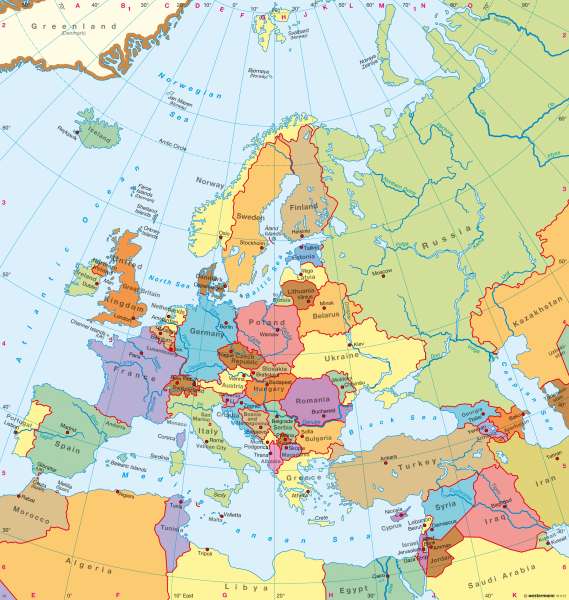Europe — Political map
Europe - Countries
978-3-14-100790-9 | Page 38 | Ill. 1

Information
The map of Europe in the early years of the 21st century reveals the far-reaching territorial changes that resulted from the end of Soviet dominance in Eastern and South-eastern Europe. Yet it still shows several boundary lines drawn in the aftermath of the Second War. Germany, for example, which had launched the war for the purpose of recovering losses imposed by the Treaty of Versailles, was stripped of roughly a quarter of its former territory in 1945, while the Soviet Union made substantial territorial gains in Europe. Romania was compelled to renounce its claims to Bessarabia and Bukovina, Czechoslovakia to cede Carpatho-Rus and Poland to give up all of its eastern provinces. In return, Poland's western border was shifted to the Oder-Neisse Line.The collapse of the East Bloc
Europe remained divided into two hostile blocks under the influence of the East-West conflict until the late 1980s. One the one side stood the East Bloc states allied with the Soviet Union, on the other a group of Western nations sympathetic to the United States of America. One of the most momentous events was the introduction of perestroika (restructuring) during the administration of Mikhail Gorbachev, the New Secretary General of the Soviet Communist Party. While the reform programme progressed rather slowly in the Soviet Union, the democratization process spread rapidly in the other countries of the East Bloc, in which the old rulers were forced to submit to popular pressure and — because the Soviet Union refused to intervene with military force — give way to democratically elected governments. With the exception of Romania, the transition was accomplished peacefully, for the most part.
The demise of the East Bloc paved the way for the reunification of the two German republics proclaimed in 1949, but also for the division of Czechoslovakia, which took place in 1993, a year after the Republic of Slovakia declared its independence. National liberation movements had also led to the secession of Slovenia and Croatia from Yugoslavia in 1991. The recognition of their governments by the Federal Republic of Germany was the starting signal for a lengthy and extremely bloody civil war, during the course of which the multi-ethnic state of Yugoslavia was split into six autonomous republics: Slovenia, Croatia, Bosnia and Herzegovina, Serbia, Macedonia and Montenegro.
The demise of the Soviet Union
Centrifugal tendencies also emerged in the Soviet Union soon after the political change of course. Islamic ethnic groups in Central Asia, the peoples of the Caucasus and the republics along the western border demonstrated particularly strong opposition to the idea of a unified "Soviet people". In the spring of 1990, the parliaments of the three Baltic Republics of Estonia, Latvia and Lithuania adopted declarations of independence. The Soviet Union responded immediately with an economic blockade of Lithuania, which was suspended in the summer following the temporary rescission of the declaration. In early 1991, the Soviets reacted with military force in an effort to suppress the independence movement, yet both the attempted coup in Lithuania and the attack on the Ministry of the Interior in Riga were unsuccessful. A plebiscite in February and March 1991 confirmed the parliamentary resolutions. International recognition and accession to the UN followed that same year. As the first states to secede from the Soviet Union, the Baltic Republics thus unleashed a virtual avalanche of liberation movements.
The process culminated in the complete collapse of the Soviet Union, which was formally dissolved following Mikhail Gorbachev's resignation in December 1991. In addition to Estonia, Latvia and Lithuania, the independent republics of Russia, Belarus, Ukraine, Moldova, Georgia, Armenia, Azerbaijan, Turkmenistan, Uzbekistan, Tajikistan, Kirgizstan and Kazakhstan were constituted within the former boundaries of the Soviet Union. Twelve of these successor states formed the Commonwealth of Independent States (CIS). However, due to conflicts of interest between the member states, the CIS has failed to fulfil the expectations of its founders at any time in its short history.
The new governments of the former East Bloc nations quickly opened the doors of their countries to the market economy and initiated efforts to gain accession to NATO and the EU. The Warsaw Pact was formally dissolved in 1991. Poland, the Czech Republic and Hungary joined the NATO alliance in 1999, followed by Bulgaria, Estonia, Latvia, Lithuania, Romania, Slovakia and Slovenia in 2004. In the course of phases I and II of EU eastern expansion, all of these countries also became Member States of the European Union, with Romania and Bulgaria being the last to join on January 1, 2007.
Dwarf states and autonomous territories
Greenland and the Faroe Islands are autonomous territories under Danish rule. Norway holds the offshore territory of Svalbard, which comprises the Spitsbergen and Bear Islands. Gibraltar has been a British possession since 1704. In a plebiscite conducted in 1967, the overwhelming majority of its population voted to remain within the British Commonwealth, and the peninsula adopted its own constitution in 1969.
Cyprus has been divided by a line of demarcation into the Greek Republic of Cyprus (which encompasses two sovereign British military bases) and the Turkish Republic of Northern Cyprus, which has not gained international recognition to date.
Liechtenstein formed a customs and monetary union with Switzerland in 1923. The parliamentary principality of Monaco is linked to France by a customs union. Andorra has been a sovereign parliamentary principality since 1993 and has two heads of state: the President of France and the Bishop of Seu d'Urgell (Spain). The parliamentary republic of San Marino belongs to a customs union with Italy. The Channel Islands and the Isle of Man belong to the British crown but are not part of the either the United Kingdom of Great Britain and Northern Ireland or the European Union. They have their own governments. Vatican City was declared an independent state under the terms of the Lateran Treaty of 1929.
D. Bode, K. Lückemeier; U: J. Southard




